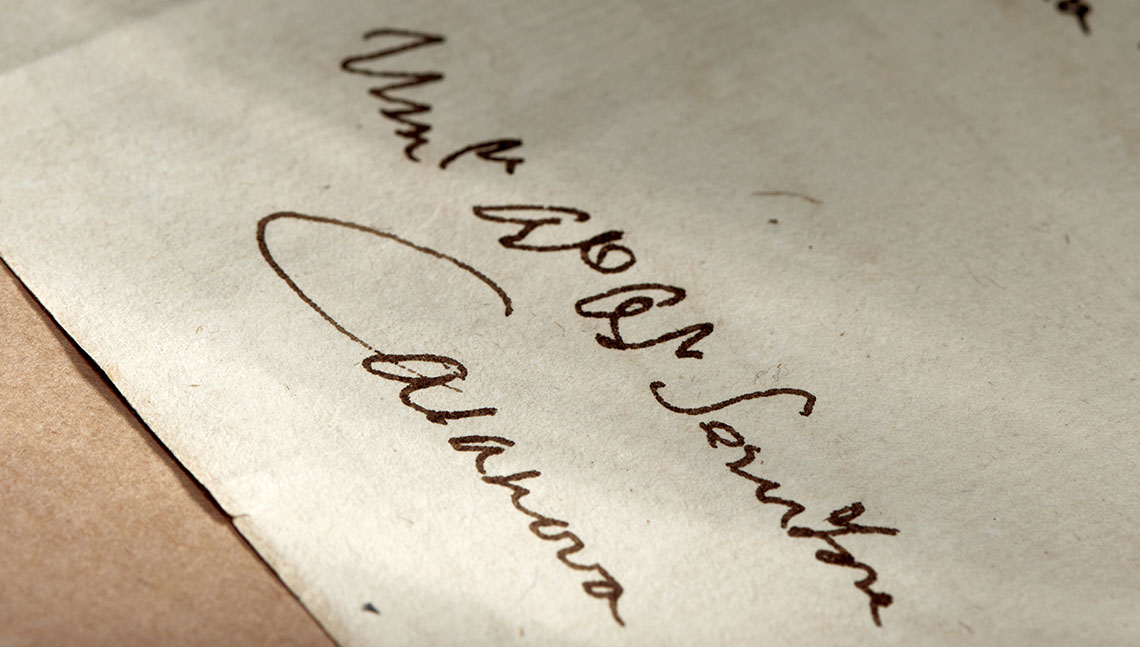Rare testimony to the greatest womanizer of all time: Casanova's handwritten letter to be auctioned off

Adventurer, rascal, swindler - Giacomo Casanova (1725-1798) was all of these things. To this day, however, the Italian bon vivant is best known as a womanizer. Even during his lifetime, he was famous (and infamous) in Europe for his charm. Casanova's reputation is legendary, but there are hardly any handwritten documents by the Italian. This makes Casanova's letter from 1791, which he wrote to Count Antonio Ottavio Collalto at Dux Castle in Bohemia, all the more significant. It provides an insight into Casanova's thinking - a rarity that will be auctioned off by Germany's largest auction house Eppli in Leinfelden-Echterdingen on April 22, 2023. The city of Stuttgart, where Eppli is based, also has a connection to the Italian seducer.
Many famous people of the 18th century achieved world renown through special deeds: musicians, composers, scientists, painters, writers or poets, scholars, politicians, thinkers and philosophers. Giacomo Girolamo Casanova was none of these things. He became famous for a single reason: he was himself.
The son of an actor couple, he knew how to sell himself better than almost anyone else - with wit, sophistication, charm and a good dose of audacity. He won over wealthy aristocrats as supporters, knew the art of good communication and the best connections and used newspapers and events such as theaters, operas, receptions and parties to put himself in the limelight. He loved attention and successfully beguiled the ladies. But the Venetian did not only make friends - Casanova was arrested and imprisoned several times. His escape from the lead chambers of Venice, as well as his thoroughly vain memoirs about his eventful life, made him so famous that the name "Casanova" still stands for seduction and the art of living today.

Ferdinand B. Eppli - Managing Director and Auctioneer
"Everyone can relate to the name Casanova; everyone immediately has an image in mind of what and who is meant by this name," says Ferdinand Eppli, Managing Director of the auction house. "And the letter confirms that Giacomo Casanova was who we still think he was today."
Casanova's letter is a testimony to this special charm. The Venetian wrote it seven years before his death, when - banished from his homeland - he found refuge at Dux Castle in Bohemia from 1785. There he worked as a librarian and wrote his memoirs. He died there in 1798 and found his final resting place in the grounds of the castle.
Casanova addresses the three pages to Count Antonio Ottavio Collalto, a Lombard nobleman, and thanks him for his New Year's greetings. He goes on to tell him about the cold in the castle, which is why he prefers to stay in his warm room. Again and again, the wit and vanity of the bustling seducer shine through: Casanova tells lavish and entertaining stories, such as how he regretfully decided not to attend a ball so as not to fall ill in the cold - even though there were many beautiful girls there.
He obviously wants to make the count laugh with a lot of wit when he also talks about a woman from Cremona. It was an acquaintance who had confided in him. She was pregnant, but had not seen her husband for two years. The cunning Casanova devised a ruse and advised the woman to pretend that her husband had an eye disease that she needed to cure. She would then - oh wonder of wonders! - as soon as she had given birth to the child and could pretend that nothing had happened.
Der drei Seiten lange Brief ist ein Doppelblatt mit Wasserzeichen und Goldschnitt. Casanova schrieb ihn auf Italienisch, wobei das Schreiben vollständig transkribiert worden ist. Dass der Brief tatsächlich von dem Lebemann aus Venedig verfasst worden ist, belegt ein Echtheitszertifikat eines renommierten Schriftsachverständigen. „Handgeschriebene Schriftstücke von Giacomo Casanova sind äußerst selten; dieser Brief ist eine Rarität“, erklärt Sebastian Pumpmeier, bei Eppli zuständig für den Bereich Historika. Die Expertinnen und Experten von Eppli untersuchen solche Schriftstücke ebenfalls: Sie machen sowohl eine Papier- als auch eine graphologische Analyse. Auch prüfen sie alle Angaben: Wann lebte der Adressat – zu der gleichen Zeit wie Casanova? War eine Bekanntschaft der beiden möglich? Sind die Angaben in dem Brief schlüssig und korrekt?
Sie sind es – der Brief wird am 22. April bei der Auktion mit der Aufrufnummer 14 und einem Startpreis von 17.500 Euro angeboten.
Just last November, Eppli auctioned off another rare piece of writing: a handwritten letter from Queen Elizabeth II. This auction was very successful and met with a great response - and so the owner of Casanova's letter also became aware of Eppli and approached the auction house.

Sebastian Pumpmeier - expert for historica
"Such a document is interesting for collectors and investors, for example, but also for museums and institutes that want to maintain and add to large collections."
Casanova und Stuttgart: Diese Verbindung ist nicht neu. Im Jahr 1760 kam Giacomo Casanova in die Stadt – als Begleiter zweier Frauen, Mutter und Tochter, die er offenbar zuvor in Koblenz kennengelernt hatte. Und da Casanova Casanova war, hatte er eine Liebschaft mit beiden. In Stuttgart quartierte sich der Frauenheld im Gasthaus „Zum Bären“ am Bärenplatz ein, der später zum Dorotheenplatz umbenannt wurde. Casanova tat das, was er immer tat: Er vergnügte sich, becircte die Damenwelt, feierte und ließ sich aushalten. Am Ende hatte er einige Menschen gegen sich aufgebracht und musste bei Nacht und Nebel aus Stuttgart fliehen. An den Aufenthalt des umtriebigen Venezianers erinnert eine Gedenktafel am Eingang der Bärenstraße – nur wenige Meter entfernt von einem Standort des Auktionshauses Eppli.
Der Brief von Giacomo Casanova wird im Rahmen der „Best Of“-Auktionen versteigert, wobei am 22. April 2023 um 15 Uhr an Epplis Standort Leinfelden-Echterdingen Münzen, Briefmarken und Historika im Mittelpunkt stehen. Auf der Website von Eppli bekommen Sie einen Überblick über alle zu versteigernden Objekte sowie Startpreise und Informationen:
https://auktionen.eppli.com/de/2785_best-of_muenzen_briefmarken_historika/a/1779
Informationen zum Brief Giacomo Casanovas:
https://auktionen.eppli.com/de/l/239532/casanova_extrem_seltener_brief_des_bekannten_abenteurers?aid=1779
Außerdem können Sie die Auktion online verfolgen, mitbieten und auch Vorgebote abgeben.
 Deutsch
Deutsch
 English
English